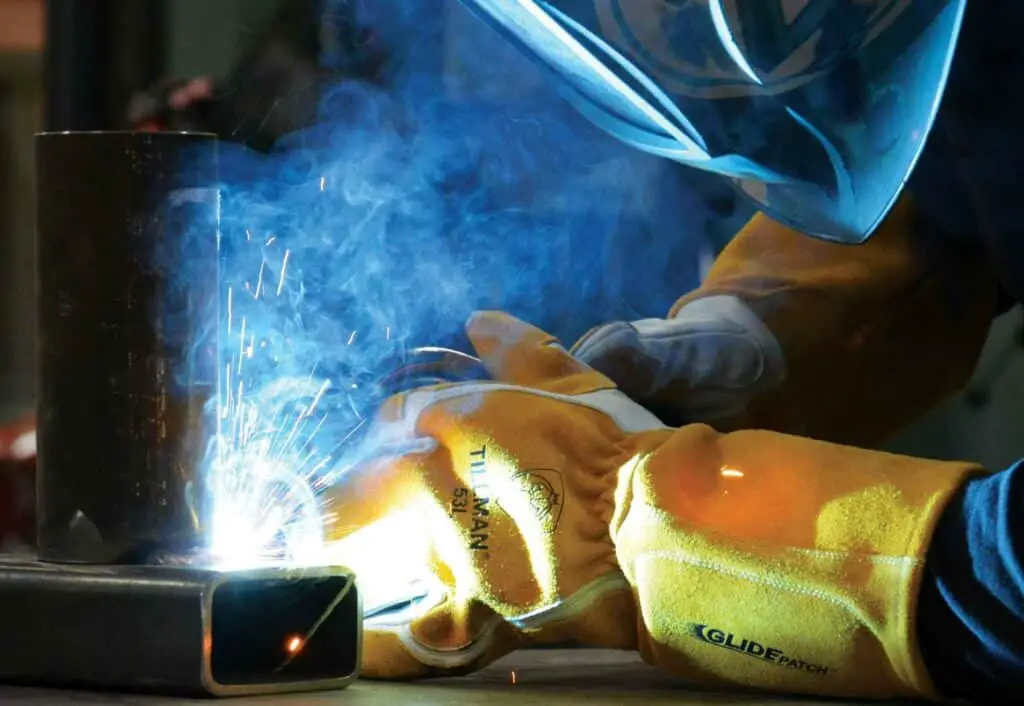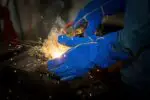Whether you are a beginner/professional welder or a welder as a hobby for DIY projects, safety is everything. The correct PPE can mean the difference between a life-threatening injury and your personal health, and particularly for your hands. Welding safety gloves are the only barrier between that welding flame and your hands.
We consulted a group of professional welders and requested they test numerous welding gloves right on the job. They considered heat protection, shock protection, radiation, and grip.
After several weeks of trials, we chose as our best MIG welding gloves the Tillman 50L Gloves for Welding because of the great glove feel and grip they offer while protecting. We also liked the Rapicca Forge Welding Leather Gloves for their superb heat resistance on the job.
| Welding Gloves | Outer material | Inner lining | Cuff length | Stitching |
|---|---|---|---|---|
| John Tillman & Co. 50L Gloves for Welding | Cowhide | Fleece | Four inches | Kevlar |
| Lincoln TIG Welding Gloves in Grain Leather | Grain leather | No lining | Four inches | Kevlar |
| Caiman 1878-5 Deerskin Stick Welding 21-inch gloves | Deerskin | – | Twenty-one inches | Kevlar |
| Rapicca Forge Welding Leather Gloves | Leather | Flame resistant aluminum laminated to cotton | Sixteen inches | Kevlar |
Why Wear Welding Gloves?
Welding is a dangerous art. Injuries are always right around the corner from lacerations to skin being degloved or torn from the hand to hands being crushed.
In fact, professional welders will not weld without the correct protective equipment. Burns are a common risk. Rather than why wear gloves, the question is considering all the safety risks, why not wear gloves?
The Reviews
Best MIG welding gloves
1. John Tillman & Co. 50L Gloves for Welding
- Tillman Large Top Grain Leather MIG Gloves With Split Leather Palm Reinforcements, Split Leather Back, Fleece Lining, Seamless Forefinger And Elastic Back (Carded)
- Long lasting top grain cowhide palm with cowhide split reinforcements.
- Welders Gloves
- Made in: United States
Prices pulled from the Amazon Product Advertising API on:
Product prices and availability are accurate as of the date/time indicated and are subject to change. Any price and availability information displayed on [relevant Amazon Site(s), as applicable] at the time of purchase will apply to the purchase of this product.
These Tillman welding gloves afford you a great glove feel in a MIG glove offering durability, protection, and comfort.
The rough exterior coupled with leather fingers and palms and reinforced thumbs give great protection thanks to the high-quality cowhide used in the construction.
Palms are very thick but at the same time very soft guaranteeing flexibility and grip. The cowhide back of the hand is particularly durable, resistant to both spatters and flying sparks.
The inner lining is in fleece that is both comfortable and lightweight. The lining also protects from both heat and flames.
Pros
-
-
- Hand back and palm are completely heat resistant
- Seamless forefingers for flexibility
- Comfortable fleece lining
- Thumb is winged for better feel and grip
- Reinforcement of backs, fingers, palm, and thumb
- Back is elastic for a great fit
- Wrist protection from a 4-inch cuff
-
Cons
-
-
- One size only: large
-
Best TIG welding gloves
2. Lincoln TIG Welding Gloves in Grain Leather
- HIGH DEXTERITY
- HIGH STRENGTH SEAMS
- LEATHER REINFORCEMENT
- DURABLE LEATHER CUFF
- USED BY PROFESSIONALS
Prices pulled from the Amazon Product Advertising API on:
Product prices and availability are accurate as of the date/time indicated and are subject to change. Any price and availability information displayed on [relevant Amazon Site(s), as applicable] at the time of purchase will apply to the purchase of this product.
These Lincoln TIG welding gloves offer an exceptional feel for great dexterity when performing TIG welding.
These gloves forgo an internal lining but offer fingers sewn with Kevlar thread in three parts to enhance feel every step of the way including both torch movement and filler wire.
They are resistant to cuts so the metal you are working with will pose no danger to your hands and they feature thumb patches that protect from wear while adding a layer of protection.
A longish cuff of 4 inches will protect your wrists and help avoid burns if you happen to lean into the metal being welded.
They are not designed for prolonged hot metal contact but do afford an exceptionally sensitive touch during welding all the while protecting.
Pros
-
-
- Grain leather exterior
- No lining
- Kevlar sewn
- High dexterity
- Resistant to cuts
- 4-inch cuff
-
Cons
-
-
- Stain easily
- Not heat resistant for direct touching
-
Best Stick Welding gloves
3. Caiman 1878-5 Deerskin Stick Welding 21-inch gloves
- Super supple Genuine American Deerskin tanned in U.S.A and Boarhide leather heat shield patch, reinforced palm, cuff and lean-on patch
- Sock-lined FR cotton fleece insulated and Boarhide leather pull-strap
- Sewn with Kevlar thread and Complimentary 3” carabineer to keep gloves together with exclusive Caiman loops on each pair
Prices pulled from the Amazon Product Advertising API on:
Product prices and availability are accurate as of the date/time indicated and are subject to change. Any price and availability information displayed on [relevant Amazon Site(s), as applicable] at the time of purchase will apply to the purchase of this product.
Manufactured for stick welding, overhead welding, or plasma cutting, these welding gloves are made of American deerskin by industry leader Caiman.
There offer 21 inches of protection along with heavy-duty padding and a palm that is reinforced. They also have a boar head leather patch to shield you from heat together with lean and cuff patches.
The gloves are stitched with Kevlar thread and boast a Kontour design to increase both comfort and fit. Caiman is the first glove manufacturer to create this type of design which molds to your hand’s shape and to your fingers to prevent slippage.
They also offer an exceptional range of mobility and dexterity. A large patch over the wrist gives added protection and palm patches increase durability.
Pros
-
-
- Durability
- Comfort
- Exceptional heat resistance
- Reinforced
- Good fit
-
Cons
-
-
- No small sizes
- More expensive
-
Best Heat Resistant Welding Gloves
4. Rapicca Forge Welding Leather Gloves
- REINFORCED DOUBLE LAYER KEVLAR PADDING ON FINGER
- EXTREME FOUR LAYER HEAT RESISTANT PROTECTION
- SUPERIOR SECURITY FOR FORERAMS
- EXTREME WEAR RESISTANT PROTECTION
Prices pulled from the Amazon Product Advertising API on:
Product prices and availability are accurate as of the date/time indicated and are subject to change. Any price and availability information displayed on [relevant Amazon Site(s), as applicable] at the time of purchase will apply to the purchase of this product.
Industry leader Rapicca manufacturers all types of hand protection. These forge welding gloves are produced in leather that is both heat resistant and flame resistant. They feature Kevlar padding on palms, elbows, fingers, and hand backs that are double reinforced.
All padding and glove components are stitched together with Kevlar thread, making this glove exceptionally resistant to heat. They can protect from extreme temperatures up to 500°C or 932°F. Arm protection consists of 16-inch-long arm coverings.
These gloves boast a liner that is insulated and resistant to flame thanks to a composite material made of high heat resistant aluminum laminated to cotton that is flame resistant, so you have a cushioned flame-resistant inner glove.
They are not designed for long-term direct contact with hot metals. They should not be washed but can be wiped clean and left to dry.
Pros
-
-
- Insulated, cushioned lining that is resistant to flames
- Forearm protection
- Generous design makes removal easy
- Exceptionally resistant to heat
- Affordable
-
Cons
-
-
- One size only
-
Welding Glove Features
Not every glove will offer identical features, however important qualities to look for in welding gloves include:
1. Insulation and resistance to heat and burn prevention
Burn prevention qualities are necessary as this is the most common injury risk in welding, especially when using an arc welding application. Molten metal will splatter and can reach a welder’s eyes, face, body, legs, feet, and of course hands.
The intense amount of heat produced in welding, often more than 7000°C, meaning it can burn a hole right through a hand. New technology now offers gloves that not only prevent burns, but that will not wither or contract if they come into contact with molten materials.
Gloves manufactured in cowhide leather or gloves that are aluminized can offer resistance to extreme heat temperatures.
2. Electrical shock insulation and radiation protection
When working with various welding processes both ultraviolet and infrared radiation is a consideration as well as electrical shock. Good protective welding gloves will protect from both electrical shock and radiation.
3. Resistance to moisture or moisture absorption
Considering that welders work with intense heat while welding, resistance to moisture perspiration is important for preventing irritation and discomfort.
4. Resistance to punctures, and tears or cuts
Resistance to punctures or tears is fundamental. Welders are not only at risk for burns but are at serious risk of cuts or puncture wounds from the pieces of metal when working.
Wounds of this nature can prevent welders from returning to work causing the loss of activity and income. Gloves produced in cowhide or pig hide can prevent punctures and cuts.
5. Construction Material
The most common material utilizes in the manufacturing of welding gloves is leather, however, there are various types for you to consider:
Cowhide is a well-known material for welding glove manufacturing. It offers both comfort and durability. It may be a little bulky for certain welding applications, in fact, it is most often used in gloves for stick welding and MIG welding.
Deerskin. This is a very pliable material that guarantees dexterity. Many gloves manufactured for TIG welding will be produced in deerskin.
Elkskin. This particular leather will not harden as quickly as others when exposed to extreme heat. Since it is less bulky and maintains suppleness, your hands will suffer less fatigue. It is used generally in gloves made for stick welding and MIG welding.
Goatskin. A very strong leather that resists abrasion, it retains its softness, so it is often used for TIG welding gloves due to lasting suppleness.
Horsehide. Long-lasting and rugged, it is less commonly used in gloves. Gloves made of horsehide offer dexterity and are often indicated for TIG welding applications.
Pigskin. A versatile leather used in TIG, MIG, and Stick welding applications, it can be used in wet circumstances as well as oily conditions.
6. Construction Features
Other things that should be considered when considering the construction of a pair of welding gloves include:
Cuff size. The length of the cuff will determine how much protection your arms have during welding and specifically shielding you from the arc. If the cuff is longer, you will have increased protection.
Glove lining. Linings will come in various materials. Cotton linings offer more flexibility while wool will offer more resistance to heat. Fleece linings are also available but make create difficulty when you remove them if your hands are sweaty.
Stitching. Stitching is very important when selecting a welding glove. Most will use Kevlar thread as it is resistant to heat and much more robust than cotton thread.
The stitching needs to be resistant to heat or else your gloves will fall apart during use. Another feature that can protect the glove stitching is welted fingers.
7. Motion flexibility
Gloves produced with high-quality top-grain leather permit better hand flexibility and motion control. This allows welders more precision and less risk of dropping metals and welders.
8. Durability
This is also a consideration when investing money. Welders need a pair of protective gloves that will last to avoid repeated purchases and expenses.
9. Comfort
This quality is such that no welder can afford to discount. Discomfort can contribute to accidents and to distraction on the job.
10. Cost
While your wallet will have a say in how much you can spend, quality and durability should be your primary concern. A few extra dollars today can protect you tomorrow and afterward.
Gloves and Welding Processes
The types of welding applications you perform will influence the type of gloves you eventually select.
The three most common welding applications are TIG, MIG, and Stick welding.
MIG or Metal Inert Gas welding gloves are often produced in goatskin or similar and feature a lining that is heat resistant.
As spatter is typical of MIG welding, the proper gloves need to protect your hands from extreme heat and molten splatter. Most will have several layers and are thus thicker than other types of welding gloves.
TIG or Tungsten Inert Gas Welding gloves usually are made from leather that is exceptionally pliable and thinner than other gloves such as goatskin. These gloves need to guarantee dexterity and easy movement for the delicate kinds of applications that TIG welding is used for.
Gloves can be thinner because TIG welding creates less spattering, however, they usually feature more palm padding and outside hand padding to withstand the extremely hot surfaces encountered in TIG welding. Another important and essential feature is that they should be easily removable when they heat up.
Stick Welding gloves are produced in thicker leather-like elk skin, goatskin, or pigskin. Stick welding does not require exceptional dexterity but does require singular thickness, because of the intense extreme heat that this welding application gives off.
Conclusion
As we previously stated, welding is a dangerous art. So many things can go wrong, and when they do, if you are without the correct protection, the consequences can be both painful and permanent.
The right welding gloves cannot only save your hands but your life. Depending on which welding applications you perform, the best pair or pairs of gloves will make all the difference for both your safety and your professional performance.











